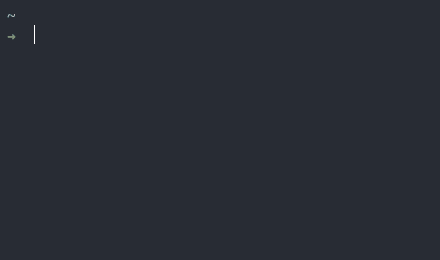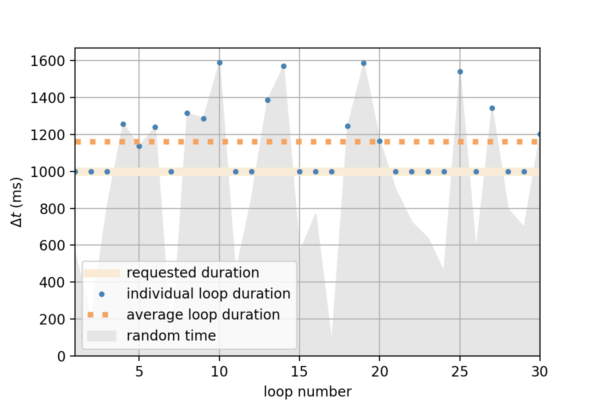oclock is a Python 3 package. Its main goal is to provide a simple way to create timed loops with constant time intervals and no drift. It also provides various other timing tools and a GUI time.
No drift, timed loops are based on the Timer class,
- either using the
checkpt()method at a location in a for/while loop acting as a reference point to maintain constant duration from one loop to the next, - or using the
@loopor@interactiveloopdecorators that useTimerandcheckpt()in the background.
The timing (interval) and execution (pause/stop etc.) can be modified in real time thanks to cancellable sleeping times.
Event: class mimickingthreading.Event()but with much better sleeping time accuracy.Countdown: a class that starts a GUI countdown timer.parse_time()function: returns adatetime.timedeltafrom a time string (e.g.':2:25').measure_time()andmeasure_duration()functions: are context managers for measuring time and execution times / time uncertainty of encapsulated commands.- Note that the
Timerclass can also be used as a regular chronometer with its methodspause(),resume(),stop()etc.
pip install oclockThe Timer class is mostly designed to create loops of constant duration without drift, while allowing immediate modification/cancellation (sleep time interruption) in threaded environments. It can also be used as a regular chronometer.
Below are some peudo-code quick-start examples. For complete, working examples, see:
- Examples.ipynb notebook (https://github.com/ovinc/oclock/blob/master/Example.ipynb)
- example.py script (https://github.com/ovinc/oclock/blob/master/example.py)
The most basic use of the Timer() class in Python code to create a loop of constant duration is:
from oclock import Timer
timer = Timer(interval=2) # Loops will be of total duration 2 seconds
while condition:
my_function() # can be of any duration between 0 and 2 seconds
timer.checkpt()The checkpt() method waits the adequate amount of time to make the loop of constant duration, without drift (using a target regularly spaced in time); condition can include timer methods and attributes, e.g. timer.elapsed_time < max_time.
Note that if my_function() takes longer to execute than the required time interval, the Timer class does not try to compensate the extra time by making the next loop shorter. It just aims at making the total duration of the next loop be the requested interval again (see Behavior when interval is exceeded section below).
The same behavior can be achieved using the @loop decorator:
from oclock import loop
timer = Timer(interval=2) # Loops will be of total duration 2 seconds
@loop(timer)
def my_function():
...Then, calling my_function() will execute the contents of the function in a repeated manner.
The @loop execution exits automatically if the timer is stopped.
Thus, It is useful to include a condition in my_function to exit the loop when needed, e.g.
if timer.elapsed_time > t_max:
timer.stop()The timer is also modifiable (change time interval) and cancellable in real time (i.e. even when the timer is in a checkpt() waiting phase). To do so, it must be accessed by another thread that runs concurrently. For example:
from oclock import Timer
from threading import Thread
def user_input(timer):
"""Threaded command line input to change time interval or exit timer."""
while not timer.is_stopped:
a = input()
try:
dt = float(a)
except ValueError: # immediately cancel timer & exit all loops/threads
timer.stop()
else: # immediately change interval to input value
timer.interval = dt
timer = Timer(interval=2)
Thread(target=user_input, args=(exit_event, timer)).start()
while not timer.is_stopped:
my_function()
timer.checkpt()During operation, the Timer object can be paused, resumed, stopped and reset using the corresponding Timer methods (see Regular Timer paragraph below). The oclock module also provides a simple command line interface to create a timed loop for a function and interact with it dynamically using the @interactiveloop decorator:
from oclock import interactiveloop
@interactiveloop(interval=2)
def my_function():
...Now when my_function() is called, an interactive CLI thread starts at the same time where the user can pause/resume/reset/stop the timer in real time, change its interval, and print timing information.
Although not its main purpose, the Timer class can be used as a regular chronometer with the following methods (no need to be in a threaded environment, although the methods below whould work and be cancellable in a threaded environment):
from oclock import Timer
# The timer starts counting time immediately upon instantiation.
timer = Timer()
# Temporarily pause, then resume timer
timer.pause()
timer.resume()
# Stop and restart timer completely
timer.stop()
timer.reset() # note: can be called without calling stop() first
# At any time, the elapsed time and total pause duration can be accessed with
timer.elapsed_time
timer.pause_time
timer.total_time # sum of the two other timesImportant Note: Do not use the checkpt() method after a pause() call if not in a threaded environment, this will cause the program to be in a perpetual waiting state. In a threaded environment, call resume() to unpause.
See Timer Class details section below for all methods, properties and attributes and the Development section below for accuracy information.
The oclock.Event class mimicks threading.Event (https://docs.python.org/3/library/threading.html#event-objects) but provides much better sleep time accuracy.
Available methods are the same as for threading.Event:
set()clear()is_set()wait()
Below are comments from Chris D. who originally posted the code for this class on StackOverflow (see Contributors at the end of this file):
Internally, it uses a combination of a time.sleep() loop and a busy loop for greatly increased precision. The sleep loop runs in a separate thread so that the blocking wait() call in the main thread can still be immediately interrupted. When the set() method is called, the sleep thread should terminate shortly afterwards. Also, in order to minimize CPU utilization, I made sure that the busy loop will never run for more than 3 milliseconds.
A simple graphical countdown timer based on the Timer class. It can be used either as a python main program from a shell, or as a function in Python code or console.
From a terminal:
python -m oclock 1:45:00 # start timer of duration 1 hour 45 minutes
python -m oclock 1:45: # exactly the same as above
python -m oclock 00:02:00 # start 2-minute timer
python -m oclock :2: # exactly the same as above
python -m oclock 00:00:05 # start 5-second timer
python -m oclock ::5 # exactly the same as aboveIn python:
from oclock import Countdown
Countdown('1:45:') # start timer of duration 1 hour 45 minutes(the inputs are of the same format as from the terminal, see above).
When countdown is finished, 'Done' is displayed for 5 seconds in the GUI while the console displays Countdown finished and emits a sound. Then the time passed since the end of countdown is displayed as a negative value in red. The program stops when the GUI window is closed.
The parse_time() function is used in the argument parsing of the countdown GUI from a terminal (see above). It transforms a string in the form 'h:m:s' into a datetime.timedelta object. Inputs of the form e.g. '::5' or :2:, '3:30:' are acceptable for 5 seconds, 2 minutes, and 3.5 hours, respectively.
>>> parse_time(':2:30')
datetime.timedelta(seconds=150)The measure_time() function is a context manager that saves the timing info of the encapsulated commands. This can be e.g. used in scientific experiments to get the time and time uncertainty associated with a measurement.
from oclock import measure_time, measure_duration
# ----------------------------------------------------------------------------
# Examples where one just wants to get timing info ---------------------------
# ----------------------------------------------------------------------------
with measure_time() as timing:
my_function()
print(timing)
# Out: {'time (unix)': 1604780958.0705943, 'dt (s)': 0.6218999624252319}
# (dt (s) is half the total duration. To get the total duration instead, do:)
with measure_duration() as duration:
my_function()
print(duration)
# Out: {'duration (s)': 1.1689763555421325}
# ----------------------------------------------------------------------------
# Example where the timing info is directly added to a data dictionary -------
# ----------------------------------------------------------------------------
with measure_time() as data:
measurement = my_function() # returns e.g. 3.618
data['measurement'] = measurement
print(data)
# Out: {'measurement': 3.618,
# 'time (unix)': 1604780958.0705943,
# 'dt (s)': 0.6218999624252319}from oclock import Timer
timer = Timer(interval=1, name='Timer', warnings=False, precise=False)Parameters:
interval(float): timer interval in secondsname(str): optional name for description purposes (repr and warnings)warnings(bool): If True, prints warning when time interval exceededprecise(bool) if True, increase time precision (useful for Windows)
Note: The precise=True option uses a custom Event class to replace threading.Event, originally written by Chris D. (see below).
timer.checkpt() # Reference point for constant-duration loops, see above
timer.pause() # Immediately pause timer and put checkpt() in waiting phase
timer.resume() # Restart the elapsed time counter and unlock checkpt()
timer.stop() # Stop counting time and exit checkpt()
timer.reset() # Stop and restart timer immediatelytimer.interval # get interval (in s)
timer.interval += 1 # increase interval by 1 second
timer.interval = 10 # set interval to 10 seconds.
timer.warnings # get current status of warnings
timer.warnings = True # activate warnings if time between checkpts too short
timer.name # optional name (for repr and warnings)
timer.name = 'Countdown timer' # (can also be set during instantiation)# Most useful attributes
timer.elapsed_time # Time in seconds since init or last reset
timer.pause_time # total time (in s) the timer has been paused.
timer.total_time # Sum of the last two(mostly for development)
timer.now() # Reference time used by all methods
timer.start_time # Ref. time corresponding to start/reset of timer
timer.next_checkpt_release # Ref. time at which next checkpt waittime is over
timer.interval_exceeded # (bool) True if loop contents take longer to execute than requested interval-
As mentioned previously, methods (and interval setting) take effect immediately, even if the timer is in a waiting phase.
-
After calling
pause(), thecheckpt()command blocks untilresume()is called, however in the current version afterstop()thecheckpt()becomes non-blocking (equivalent to apass), so that all following lines will be executed immediately and without any waiting time (i.e. as fast as possible if within a loop), untiltimer.reset()is called again. This means that it is useful to pin the condition of the loop to the stopping of the timer (see examples).
See performance.py file of the module for functions to test the behavior and accuracy of the timer. In particular:
from oclock.performance import performance_test
performance_test(dt=0.01, nloops=1000, fmax=0.99, plot=True, warnings=False, precise=True)tests the timing on 1000 loops of requested duration 0.01 second (10ms), using within the loop a function sleeping for a random amount of time between 0 and 0.99 dt (with plot=True option to see the results on a matplotlib graph, and warnings=False to not have a printed warning when the execution time of the nested commands exceed the target duration of the loop); precise=True uses the timer in precise mode.
The AccuracyTests.md file gathers some accuracy results in Unix and Windows environments. In summary:
-
with Unix, time fluctuations are < 0.5 ms with the regular timer, and on the order of 0.01 ms (standard deviation) with the precise timer
-
with Windows, the regular timer fails quickly as frame rate is increased, due to fluctuations in the ~ 10 ms range. However the precise timer performs even better than in Unix, with fluctuations of less than 0.01 ms (standard deviation).
As explained above, it the contents of the loop take longer to execute than the requested time interval, the Timer simply moves on to the next loop but does not try to compensate for the extra time by making the next loop shorter:
Install the package by cloning the GitHub repo (https://github.com/ovinc/oclock.git) and install in editable mode from the root of the repo:
pip install -e .
Package requirements to run the tests:
- pytest
- numpy
General testing is done with pytest (from the root of the repository):
pytest(Note: close the interactive countdown window at the end of the pytest run to finish the test.)
Additional testing of interactive command line for real-time timer control can be done by running the example file from the root of the repository.
python -m exampleSee also Accuracy Test paragraph above to run performance tests for constant-duration loops with the Timer class.
Issues and Pull requests must be submitted on GitHub (https://github.com/ovinc/oclock) with commits (preferably squashed into a single commit) in branch authors.
Version number is automatically extracted from git tag using setuptools_scm. Git tags are added by the repo's maintainer.
Python 3.x
(Tests only made from python 3.5 to python 3.9 included)
Olivier Vincent
The oclock.Event class was originally written by Chris D.
GNU GPLv3, see LICENSE file

